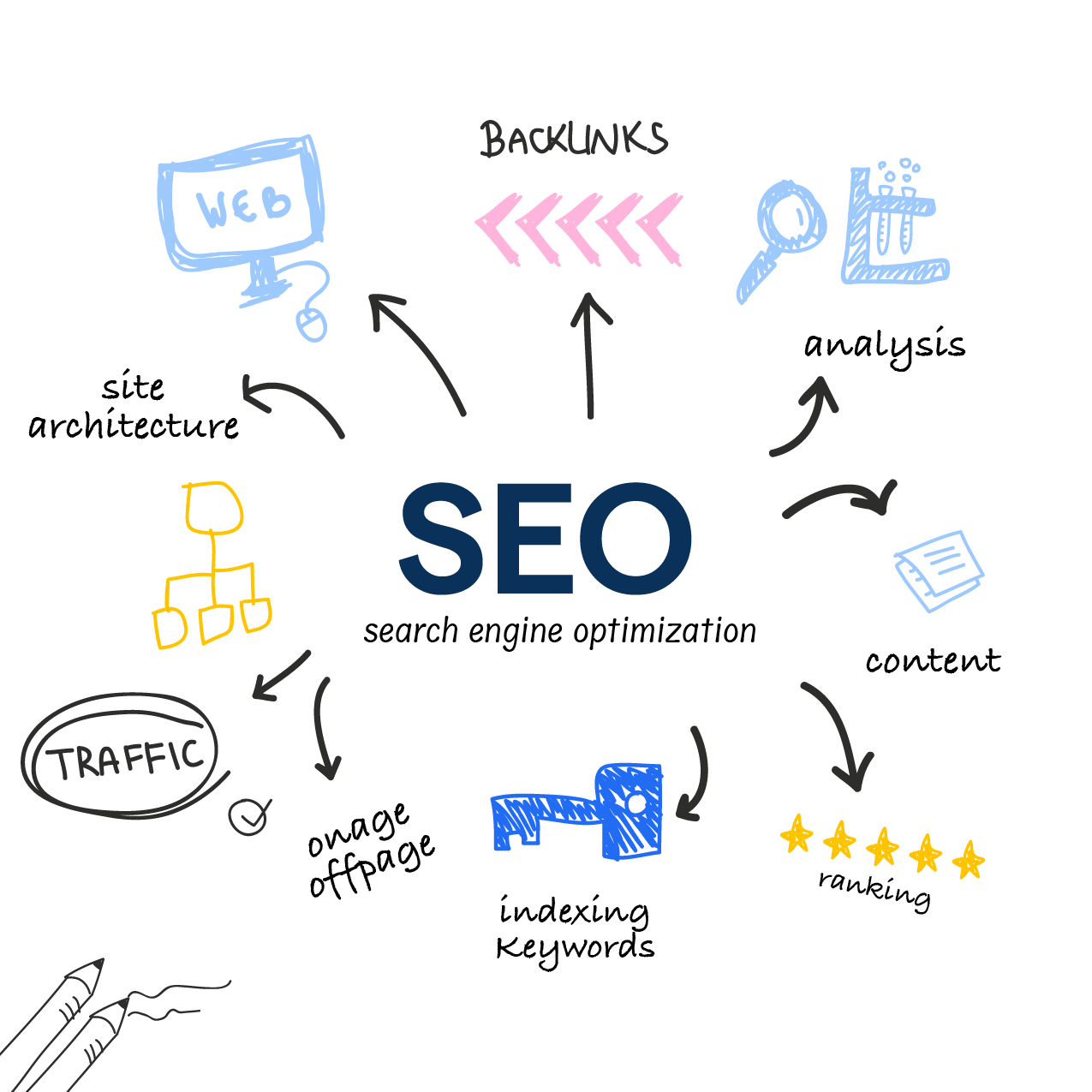Website Architecture Optimization for SEO: Strategies and Techniques

As a website owner or developer, you’ve likely heard of search engine optimization (SEO) and its importance in driving organic traffic to your site. However, did you know that the architecture and structure of your website play a significant role in SEO rankings?
Website architecture optimization refers to the process of designing your website’s structural layout to enhance its performance in search engine rankings and improve user experience. By organizing your site’s content in a logical and user-friendly manner, you can help search engines crawl and understand your website’s hierarchy, leading to increased visibility and traffic.
In this section, we’ll explore the importance of website architecture optimization for SEO and provide strategies and techniques to help you design an SEO-friendly website structure.
Key Takeaways:
- Website architecture optimization is a crucial aspect of SEO.
- Structuring your website in a logical and user-friendly manner enhances SEO performance and improves user experience.
- Optimizing website hierarchy, navigation, and page architecture are all essential elements of an SEO-friendly website structure.
- Mobile optimization and website performance are also crucial factors in SEO rankings.
- Regular maintenance and updates are necessary to maintain an optimized website architecture for long-term SEO success.
Understanding Website Architecture and its Impact on SEO
Website architecture is the structural design of a website, including its organization, hierarchy, and navigation. It plays a crucial role in search engine optimization (SEO) by helping search engines understand the content and context of a website. Understanding website architecture and its impact on SEO is essential for improving your website’s visibility and search engine rankings.
The Architecture of Search Engine Optimization
The architecture of search engine optimization involves organizing a website’s content in a way that search engines can easily crawl and understand. By optimizing website architecture, you can improve the relevance and authority of your website, making it more likely to appear at the top of search engine results pages (SERPs).
One of the primary goals of website architecture optimization is to create a clear and effective hierarchy that reflects the importance and relationship between different pages on your site. Search engines use website hierarchy to determine the significance of a page and how it relates to other pages on the site.
By website architecture optimization, you can also improve user experience by making it easier for visitors to find the information they need. A well-organized and intuitive website structure can lead to increased engagement and conversions, as well as improved search engine rankings.
Overall, understanding the architecture of search engine optimization is critical for developing an effective SEO strategy and maximizing the impact of your optimization efforts.
Types of Website Structures and Their Pros and Cons
When it comes to structuring your website, there are several types to consider. Each type has its own advantages and disadvantages, depending on your website’s goals and content organization. Let’s explore the most common types of website structures:
Hierarchical Structure
A hierarchical structure is the most common type of website structure. It arranges content in a top-down fashion, with the homepage at the top and subsequent pages organized in a hierarchical manner beneath it.
| Pros | Cons |
|---|---|
|
|
Flat Structure
A flat structure gives equal importance to all pages on the website, with no page hierarchy. The content is organized in a single level, making it easier to navigate but harder to prioritize pages.
| Pros | Cons |
|---|---|
|
|
Silo Structure
A silo structure groups related content together in separate silos, with each silo consisting of a top-level category with subcategories beneath it. It is a combination of both hierarchical and flat structures, with clear organization and navigation.
| Pros | Cons |
|---|---|
|
|
Choosing the right website structure for your site is essential for both user experience and SEO. Consider your website’s goals, content organization, and size when determining which structure to use. A well-designed structure can help users find what they’re looking for quickly and efficiently, while also improving search engine rankings.
Designing an SEO-Friendly Website Structure
Designing an SEO-friendly website structure involves organizing your content in a logical and user-friendly manner while paying close attention to SEO site architecture best practices. Doing so can positively impact your website’s search engine visibility and user experience. Below are some key considerations when designing your website’s structure:
Creating a clear and simple navigation system is an essential component of an SEO-friendly website. This includes a user-friendly menu, breadcrumbs wherever possible, and an easy-to-navigate URL structure. A clean navigation system not only helps users find the content they’re looking for but also makes it easier for search engines to crawl and index your site.
Logical and Consistent Organization
It’s essential to organize your website’s content in a logical and consistent manner. This means creating a hierarchy that reflects the importance and relationship between different pages, sections, and categories. Utilizing a consistent naming convention for similar pages and categories can also help with clarity and ease of navigation.
Optimized Internal Linking
Optimizing your internal linking structure can improve website architecture optimization by providing clear paths for both users and search engines to navigate your site. This includes linking to relevant internal pages from within your content, including the use of anchor text with relevant keywords, and creating a sitemap that outlines the structure of your website.
Fast Page Load Times
Website speed optimization can significantly impact user experience and SEO rankings. By optimizing image sizes, minifying code, and utilizing caching, you can improve your website’s loading speed. Ensure your website is responsive and mobile-friendly so that it can cater to users on a range of devices.
Implement Keywords in Title Tags and Headers
Integrating relevant keywords into your title tags, headers, and other on-page elements can improve your website’s relevancy and help search engines know what your site is all about. Ensure your website’s structure caters to these tags while maintaining a logical flow of content, creating a seamless user experience overall.
Importance of Website Hierarchy in SEO
Website hierarchy is a crucial element of Website architecture optimization, playing a significant role in SEO. The hierarchy refers to the organization of your website’s content, with the most important and broad information at the top, and more specific and detailed information at lower levels.
A well-designed website hierarchy creates a clear structure that helps both users and search engines navigate your site efficiently. Search engines use website hierarchy to understand the importance and relevance of each page, and how they relate to each other. When your website has a clear hierarchy, it can improve search engine ranking and overall visibility.
Creating an Effective Website Hierarchy
To optimize your website hierarchy, you need to start by defining your website’s goals and the primary topics or themes you want to cover. Based on these themes, you can create categories and subcategories, each with relevant pages that contain specific information.
The key is to ensure that your website’s hierarchy reflects your site’s content and user intent. Users should find it easy to navigate your website, with the most important pages accessible from the homepage. A clear hierarchy can also help search engines crawl and index your site, improving your website’s overall search engine ranking.
Proper labeling and navigation are crucial components of an effective website hierarchy. Labels should be clear and concise, accurately reflecting the information contained on each page. Navigation menus should be intuitive, with top-level categories prominently displayed and related subcategories easily accessible.
Breadcrumbs, which show users and search engine crawlers the hierarchy of a particular page, are another essential navigation feature. Breadcrumbs display a trail of links that indicate the path a user took to arrive at a particular page within the website.
Implementing an SEO-Friendly Hierarchy
To implement an SEO-friendly website hierarchy, ensure that each page on your website is accessible with no more than 3-4 clicks from the homepage. Use descriptive URLs, title tags, and meta descriptions that accurately reflect the content on each page.
Internal linking is another crucial element of an SEO-friendly website hierarchy. Linking related content within your site helps search engines understand the relationships between different pages and can improve your site’s ranking.
Conclusion
A well-designed website hierarchy is an essential aspect of website architecture optimization. By creating a clear and user-friendly structure with proper labeling and navigation, you can improve your website’s visibility and search engine ranking.
When it comes to website optimization, navigation is often overlooked, yet it plays a critical role in user experience and SEO. A well-designed navigation system ensures that visitors can easily find the information they need, while also providing search engines with a clear understanding of your site’s structure. Here are some tips for optimizing your website’s navigation:
Keep it Simple
One of the most important principles of navigation design is simplicity. Keep your menus and links organized and intuitive, avoiding clutter and unnecessary complexity. Visitors should be able to find what they need quickly and easily, without getting lost in a maze of links and dropdown menus.
Use Breadcrumbs
Breadcrumbs are a useful navigation aid that helps visitors understand where they are on your site and how they got there. They also provide search engines with additional context and help improve your site’s overall structure. Breadcrumbs typically appear near the top of the page and display the path taken to reach the current page, such as “Home > Category > Subcategory > Page.”
Create Clear and Intuitive Menus
Your website’s main menu should be clear, concise, and easy to navigate. Use descriptive labels that accurately reflect the page or content they link to, and avoid vague or generic terms. Consider grouping related pages or topics together under submenus to help visitors quickly find what they’re looking for.
Optimize Your URL Structure
URL structure is an often-overlooked aspect of navigation design, but it’s essential for both user experience and SEO. Use descriptive, keyword-rich URLs that accurately reflect the page or content they link to, making them easier for visitors to remember and share. A clear URL structure also helps search engines understand the organization and hierarchy of your site.
Ensure Fast Load Times
Slow load times can negatively impact both user experience and SEO, particularly on mobile devices. Ensure that your website’s navigation loads quickly and efficiently, avoiding heavy graphics or unnecessary scripts that can slow things down.
Conclusion
Optimizing your website’s navigation is an essential component of both user experience and SEO. By simplifying menus, using breadcrumbs, and creating clear and intuitive navigation paths, you can improve the overall structure of your site and make it easier for visitors to find what they’re looking for. Additionally, optimizing your URLs and ensuring fast load times can further enhance your website’s visibility and rankings on search engine results pages.
Improving Website Performance for Better SEO Rankings
Website performance is a critical factor in achieving better search engine rankings and providing a positive user experience. A website that loads slowly or experiences frequent downtime can negatively impact your SEO efforts and discourage users from returning to your site.
Here are some tips for optimizing your website’s performance to improve SEO:
1. Optimize Images
Large, high-resolution images can significantly slow down your site’s loading times. To reduce the file size of your images without compromising quality, use image compression tools such as Adobe Photoshop, TinyPNG, or Kraken.io. Additionally, be sure to use the correct image format for each type of graphic, such as using JPEG for photographs and PNG for graphics with transparent backgrounds.
2. Minify Code
Minifying your website’s code, including HTML, CSS, and JavaScript, can help reduce its size and improve loading times. You can use tools such as MinifyCode.com or CodeKit to automatically remove unnecessary spaces, comments, and other characters from your code.
3. Enable Caching
Caching involves storing frequently accessed data on a user’s computer or browser, allowing web pages to load more quickly on subsequent visits. Enabling caching on your website is a simple and effective way to reduce load times and improve user experience.
4. Use a Content Delivery Network (CDN)
A content delivery network (CDN) is a network of servers distributed across multiple locations that can deliver your website’s content from the server closest to the user’s location. Using a CDN can significantly reduce page load times, especially for users accessing your site from different parts of the world.
5. Monitor Website Performance
Regularly monitoring your website’s performance metrics, such as loading times and bounce rates, can help you identify areas for improvement and optimize your site accordingly. Use tools such as Google Analytics or GTmetrix to track your site’s performance and implement changes based on the data.
By implementing these website performance optimization techniques, you can improve your site’s SEO rankings and provide a better user experience for your visitors.

Mobile Optimization and Its Impact on SEO
In today’s digital age, optimizing your website for mobile devices is a must. With more than half of all internet traffic coming from mobile devices, having a mobile-friendly website is essential for SEO success.
Mobile optimization refers to the process of designing and developing a website to provide a seamless user experience on mobile devices, including smartphones and tablets. A mobile-friendly site is easy to navigate, loads quickly, and displays content effectively on small screens.
Why Mobile Optimization Matters for SEO
Search engines like Google prioritize mobile-friendly websites in their search results. In fact, Google has been using mobile-first indexing since 2018, which means it primarily uses the mobile version of a website’s content for indexing and ranking.
This makes having a mobile-friendly website critical for SEO success. If your site is not optimized for mobile devices, it is likely to rank lower in search results, reducing your visibility and organic traffic.
Tips for Creating a Mobile-Friendly Website
Here are some tips for creating a mobile-friendly website that will enhance your SEO efforts:
- Use a responsive design that adapts to various screen sizes and orientations
- Ensure that font sizes and button sizes are large enough to be easily read and clicked on a mobile device
- Use high-quality images that are optimized for mobile devices and load quickly
- Avoid using pop-ups or interstitials that could obstruct the content on the screen
- Ensure that your website’s navigation is easy to use and mobile-friendly
- Use structured data to make it easier for search engines to understand your content
- Optimize your site’s loading speed by compressing images, minifying CSS and JavaScript files, and using browser caching
Conclusion
In conclusion, mobile optimization is an essential component of SEO. By creating a mobile-friendly website, you can improve your visibility and rankings on search engine results pages, driving more traffic to your site and providing a better user experience for mobile users.
Integrating SEO into Web Page Architecture
Website architecture optimization for SEO involves more than just the overall structure of your site. It’s essential to integrate SEO best practices into each individual web page’s design and organization. Doing so can help search engines better understand the content of your pages and improve your site’s visibility in search results.
Key Elements of SEO-Friendly Web Page Architecture
There are several key elements to consider when designing web page architecture for SEO:
- Title tags: Each page should have a unique title tag that accurately reflects the content of that page and includes relevant keywords.
- Meta descriptions: Meta descriptions provide a brief summary of the page’s content and should also include relevant keywords to help search engines understand the page’s focus.
- Headers: Use header tags (H1, H2, H3) to break up content into clear sections and help search engines understand the hierarchy and importance of each section.
- URL structure: Create clear, concise URLs that accurately reflect the page’s content and include relevant keywords.
- Internal linking: Link to other relevant pages on your site within each page’s content to help search engines understand the relationships between different pages and content.
- Image optimization: Optimize images with descriptive file names, alt tags, and captions to help search engines understand the content and relevance of each image.
Creating Content for Web Page Architecture
When creating content for your web pages, keep the following tips in mind:
- Use headings and subheadings to organize content and help search engines understand the hierarchy and importance of each section.
- Include relevant keywords naturally throughout the content, without keyword stuffing, to help search engines understand the page’s focus.
- Create high-quality, informative content that provides value to readers and helps establish your site as a credible source in your industry.
Conclusion
Integrating SEO best practices into your web page architecture is essential for improving your site’s visibility in search results. By optimizing individual pages for search engines and creating high-quality, informative content, you can establish your site as a credible source in your industry and attract more organic traffic.
Measuring the Effectiveness of Your Website Architecture Optimization
After implementing website architecture optimization strategies, it’s important to measure their effectiveness. This helps identify areas of improvement and refine your SEO-friendly website structure for optimal results. Key metrics to consider when measuring website architecture optimization include:
- Search engine rankings: Track your website’s position in search engine results pages for targeted keywords. Improved website architecture can help boost your rankings.
- Organic traffic: Analyze the amount of traffic coming to your site from search engines. An increase in traffic indicates your website architecture optimization efforts are working.
- User engagement: Use tools like Google Analytics to monitor user behavior on your site, such as time spent on page and bounce rate. Improved website architecture can lead to better user experience and increased engagement.
By regularly monitoring these metrics, you can evaluate the effectiveness of your website architecture optimization and make adjustments as needed.
Maintaining an Optimized Website Architecture for Long-Term Success
Optimizing website architecture for SEO is not a one-time task, but an ongoing process that requires continuous effort. It’s essential to regularly maintain and update your website’s structure to ensure long-term success in search engine rankings.
Conducting regular audits is a crucial step in maintaining an optimized website architecture. Audits are necessary to identify any structural or technical issues that may be hindering your SEO performance. You can use various tools to conduct audits, such as Google Search Console, SEMrush, and Ahrefs. These tools can help you identify broken links, crawl errors, duplicate content, poor URL structures, and other issues.
Another vital aspect of maintaining an optimized website architecture is updating your content organization regularly. As your website grows, your content may become disorganized, which can negatively impact your SEO performance. You should regularly check your site’s navigation and update it to reflect any changes in your content structure. This will ensure that your website hierarchy remains logical and user-friendly.
Updating Your Website Design
As search engines update their algorithms, so should you update your website architecture to remain relevant. It’s crucial to keep up with the latest website design trends, such as responsive design for mobile users. A responsive website design ensures that your site is accessible and user-friendly across all devices. Moreover, mobile-friendliness is now a ranking factor in Google’s search algorithm.
Other design elements to consider include your website’s layout, colors, and typography. A clean, minimalist design can improve user experience and make it easier for visitors to find the information they’re looking for. Your website’s loading speed is also an important factor, as slow-loading sites can negatively impact user experience and search engine rankings. You should regularly test your site’s loading speed and optimize it as needed.
Adapting to Changes in Search Algorithms
Search engines regularly update their algorithms to ensure they provide the most relevant and useful results to users. As a website owner, you must stay up-to-date with these updates and adapt your website architecture accordingly. For example, Google’s recent BERT update allows the search engine to better understand natural language and user intent. Consider adapting your content and website structure to cater to these changes.
Finally, it’s crucial to keep an eye on your website’s performance metrics, such as traffic and engagement. These metrics can help you identify areas where your SEO-friendly website design can be improved. You can use tools such as Google Analytics to track your metrics and gain insights into visitor behavior.
Conclusion
Maintaining an optimized website architecture for SEO is an ongoing process that requires regular maintenance and updates. By conducting regular audits, updating your content organization, keeping up with the latest website design trends, adapting to changes in search algorithms, and monitoring your performance metrics, you can ensure your website remains competitive in search engine rankings.
Enhancing SEO with Effective Website Architecture
Designing an SEO-friendly website structure is a crucial aspect of optimizing your website for search engines. By following best practices for website architecture, you can improve search engine rankings, enhance user experience, and drive organic traffic to your site. Here are some website architecture best practices to keep in mind:
Create a Logical Hierarchy
A clear and logical hierarchy is essential for effective website architecture. Organize your website’s pages in a way that makes sense for users and search engines. Your homepage should provide a clear overview of your site’s content and guide users to relevant sections of your site. Organize subpages and categories in a logical way that makes it easy to navigate your site.
Navigation is another crucial aspect of website architecture. Use descriptive labels for navigation menus that make it easy for users to find what they’re looking for. Use breadcrumbs to help users easily navigate back to the homepage or higher-level pages. Use user-friendly URLs that clearly describe the content of each page.
Ensure Fast Page Speeds
Page speed is an important factor in user experience and SEO. Ensure fast page loads by optimizing images, reducing server response times, using caching, and minimizing code. Fast page load speeds can reduce bounce rates and improve search engine rankings.
Optimize for Mobile Devices
Mobile optimization is essential for effective website architecture. With the majority of internet traffic coming from mobile devices, it’s important to ensure your website is mobile-friendly. Use responsive design to ensure your site works on all devices and consider implementing mobile-specific optimizations like click-to-call functionality and mobile-specific content.
Use Headers and Meta Data
Using header tags and meta data is another important aspect of website architecture. Use header tags to clearly indicate the main sections of your website and break up content into digestible chunks. Use descriptive meta titles and descriptions to help search engines understand the content of each page.
Regularly Audit Your Website
Website architecture optimization is an ongoing process that requires regular maintenance and updates. Regularly audit your website to ensure it remains optimized for search engines and user experience. Check for broken links, outdated content, and other issues that could negatively impact your site’s performance.
By following these website architecture best practices, you can create an SEO-friendly website structure that enhances user experience and drives organic traffic to your site.
Conclusion
Effective website architecture is essential for achieving better search engine rankings and driving organic traffic to your site. By optimizing your site’s structure, you can create a strong foundation for improved SEO performance.
In this article, we’ve covered a range of strategies and techniques for optimizing website architecture for SEO. We started by exploring the importance of website hierarchy and the different types of website structures, including their pros and cons. We then discussed best practices for designing an SEO-friendly website structure, covering elements such as navigation, web page architecture, and mobile optimization.
It’s also crucial to monitor and adjust your website’s architecture regularly to ensure continued success. By measuring the effectiveness of your optimization efforts and staying proactive about maintaining an optimized structure, you can stay ahead in the ever-evolving world of SEO.
Stay Ahead with Effective Website Architecture
Optimizing your website architecture for SEO doesn’t have to be a daunting task. By following the recommendations in this article and continuously refining your structure, you can improve your rankings on search engine results pages and attract more organic traffic to your site. Keep these best practices in mind and stay ahead of the competition with an effective website architecture.
FAQ
What is website architecture optimization for SEO?
Website architecture optimization for SEO refers to the process of designing and organizing the structure of a website in a way that enhances its visibility and rankings on search engine results pages. It involves strategies and techniques to improve the website’s hierarchy, navigation, and content organization, making it easier for search engines to crawl and understand.
Why is website architecture optimization important for SEO?
Website architecture optimization is important for SEO because it helps search engines understand the relevance and importance of different pages on a website. A well-optimized architecture improves crawlability, indexability, and user experience, resulting in higher search engine rankings and increased organic traffic.
What are the types of website structures and their pros and cons?
There are various types of website structures, including hierarchical, flat, and silo structures. Hierarchical structures have a clear hierarchy and are easy for search engines to understand but may result in deep navigation. Flat structures have fewer levels and offer quick access to any page but may suffer from disorganization. Silo structures group related content together, aiding topical relevance but requiring careful internal linking.
How can I design an SEO-friendly website structure?
Designing an SEO-friendly website structure involves creating a logical and user-friendly organization for your content. This includes implementing clear navigation menus, using breadcrumbs to indicate page hierarchy, optimizing internal linking, and ensuring easy access to important pages. Proper keyword research and planning can also help in structuring the website’s pages and content effectively.
What is the importance of website hierarchy in SEO?
Website hierarchy plays a crucial role in SEO as it helps search engines understand the relationship and importance of different pages on your site. By organizing your content in a hierarchical manner, with important pages closer to the top, you can better optimize your website for search engines and improve its visibility and rankings.
To optimize website navigation, you should focus on creating intuitive menus that are easy to navigate, implementing breadcrumbs for easier page hierarchy understanding, and using user-friendly URLs. By making your website navigation user-friendly, you can enhance the overall user experience and improve search engine optimization.
How does website performance affect SEO rankings?
Website performance, including factors such as speed and loading times, is an important aspect of SEO rankings. Search engines prioritize websites that provide a fast and seamless user experience. By optimizing your website’s performance through techniques like caching, image optimization, and code minification, you can improve your site’s rankings and user engagement.
Why is mobile optimization important for SEO?
Mobile optimization is crucial for SEO because a large percentage of internet users access websites through mobile devices. Search engines prioritize mobile-friendly websites in their mobile search results. By implementing responsive design, optimizing page load times, and implementing mobile-specific SEO techniques, you can improve your website’s visibility and rankings on mobile search results.
How do I integrate SEO into web page architecture?
Integrating SEO into website architecture optimization involves optimizing key elements such as title tags, meta descriptions, headers, and URL structure. Each page should have unique and descriptive title tags and meta descriptions, headers should be used to structure content properly, and URLs should be keyword-rich and user-friendly. By optimizing these elements, you can improve the visibility of your web pages in search engine results.
How do I measure the effectiveness of website architecture optimization?
To measure the effectiveness of website architecture optimization, you can analyze key metrics such as search engine rankings, organic traffic, bounce rates, and user engagement. Tools like Google Analytics can provide valuable insights into the impact of your SEO-friendly website structure on these metrics, allowing you to identify areas for improvement and refine your website’s architecture accordingly.
How do I maintain an optimized website architecture for long-term success?
Maintaining an optimized website architecture requires regular maintenance and updates. Conducting regular audits to identify any structural issues or opportunity for improvement is important. Updating content organization, adapting to changes in search engine algorithms, and staying up-to-date with SEO best practices are essential for long-term success in maintaining an optimized website structure.
How does website architecture enhance SEO?
Website architecture plays a crucial role in enhancing SEO by improving crawlability, indexability, and user experience. Optimized website architecture allows search engines to easily understand and navigate your site, resulting in better visibility and higher rankings. Additionally, a well-structured website improves user engagement and satisfaction, which further contributes to SEO success.
What is the conclusion on enhancing SEO with effective website architecture?
In conclusion, optimizing website architecture is a crucial aspect of SEO. By implementing the strategies and techniques discussed in this article, you can create an SEO-friendly website structure that improves visibility, user experience, and search engine rankings. Continuous monitoring and adjustment of your website’s architecture will ensure continued success in the ever-evolving world of SEO.
What is the conclusion of this article?
In this article, we explored various strategies and techniques for website architecture optimization for SEO. We discussed the importance of website structure, different types of structures, and best practices for designing an SEO-friendly architecture. By implementing these recommendations and continuously refining your website’s structure, you can enhance its performance in search engine rankings and drive organic traffic to your site.





